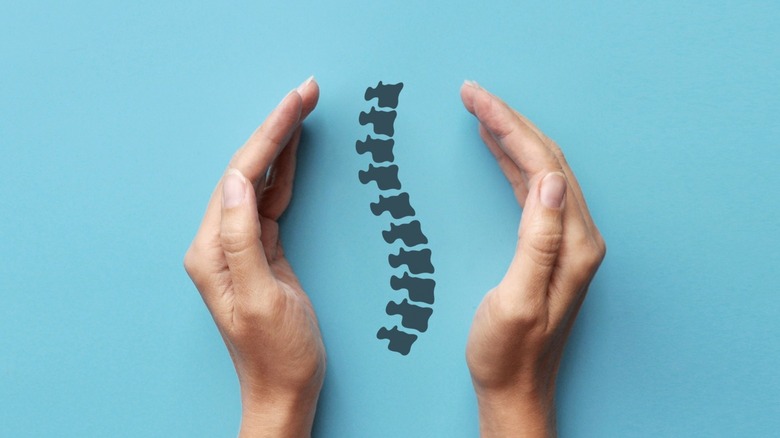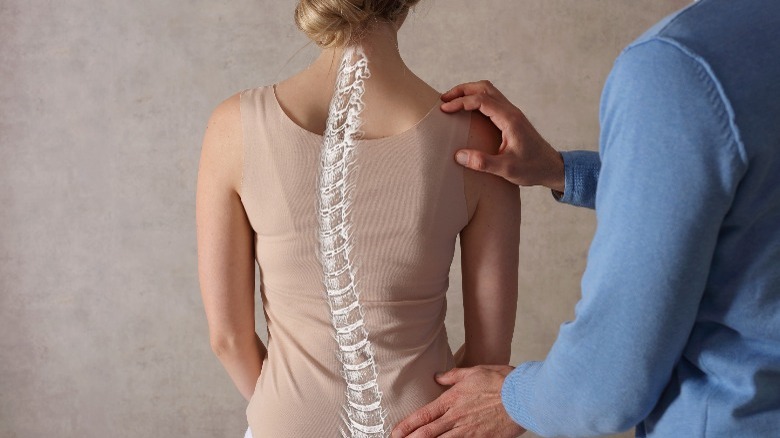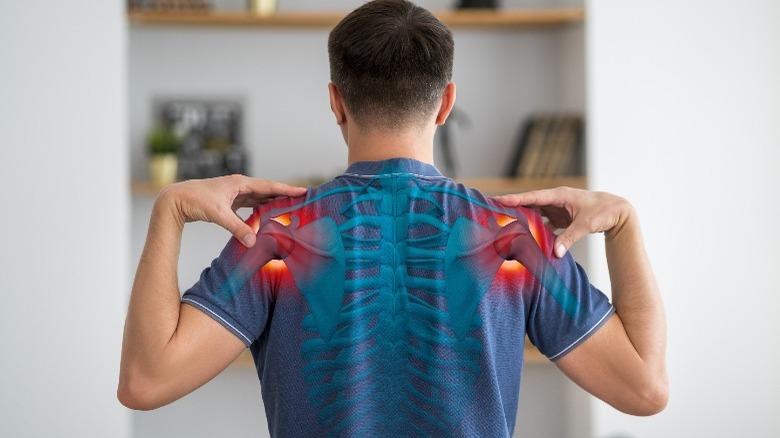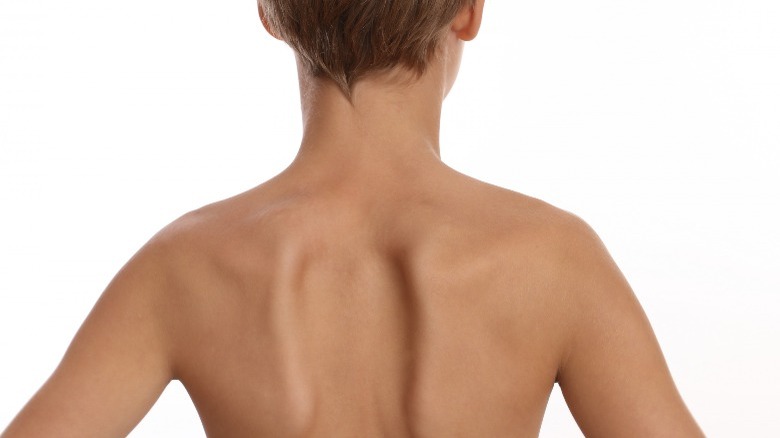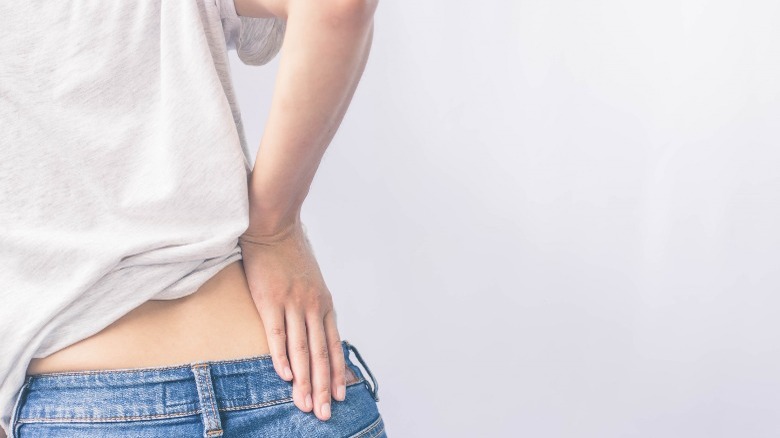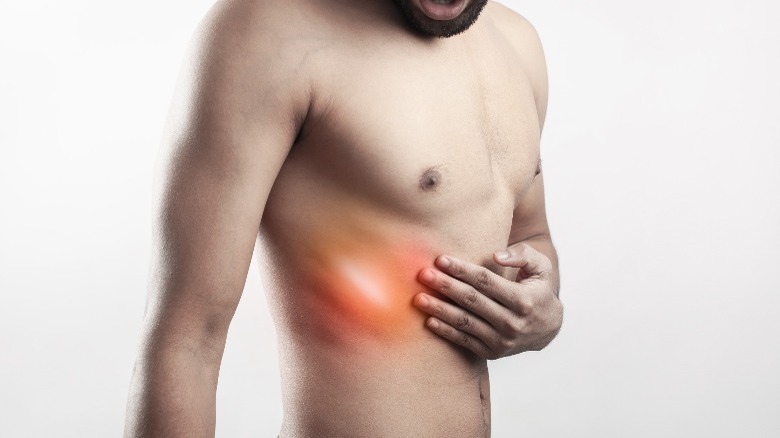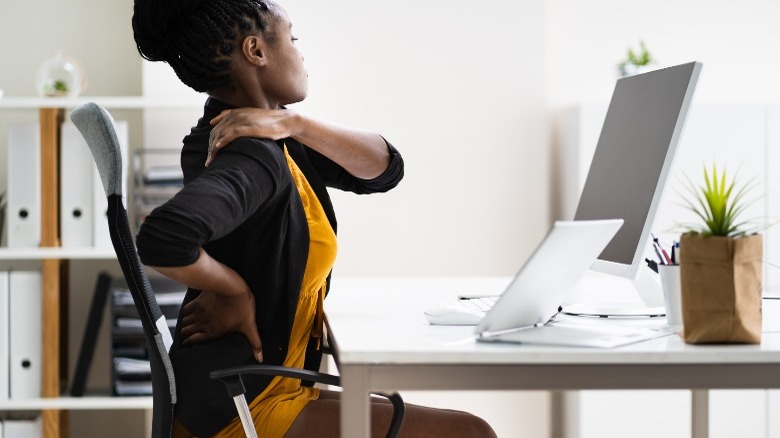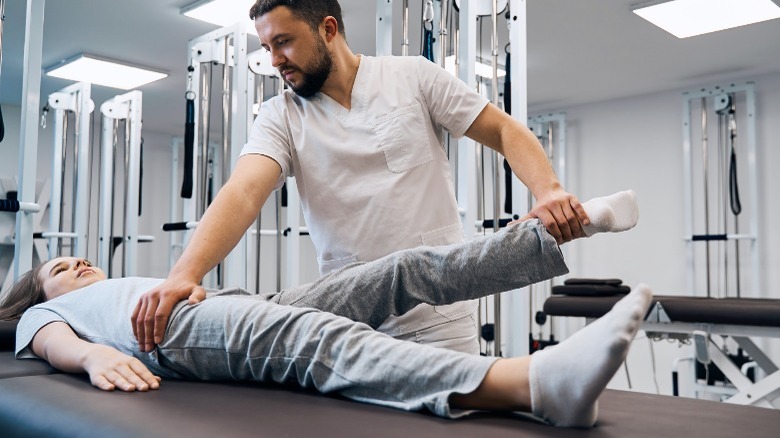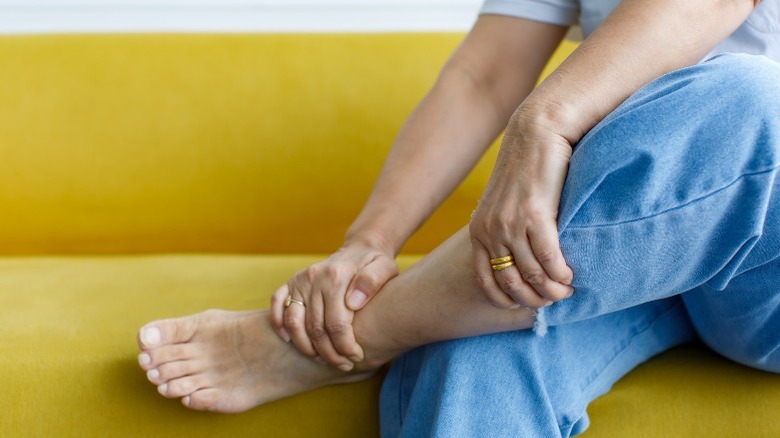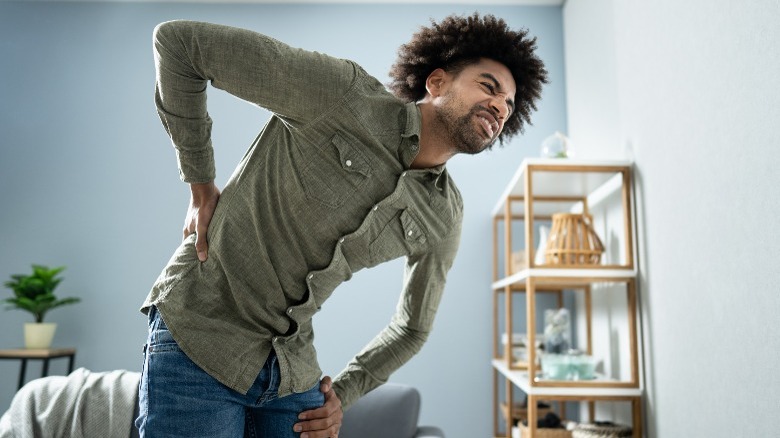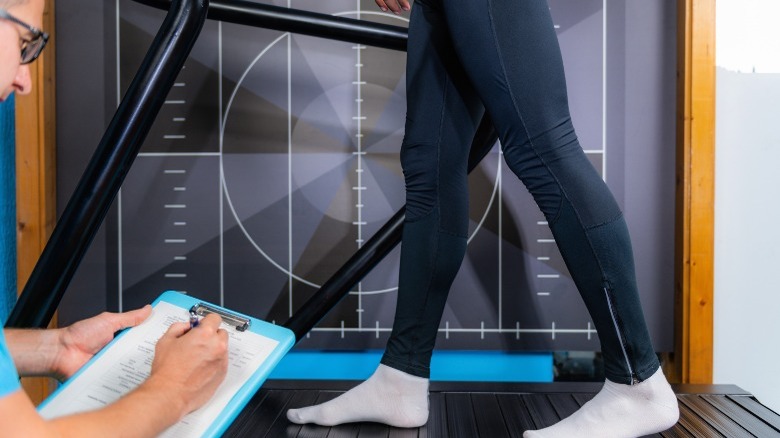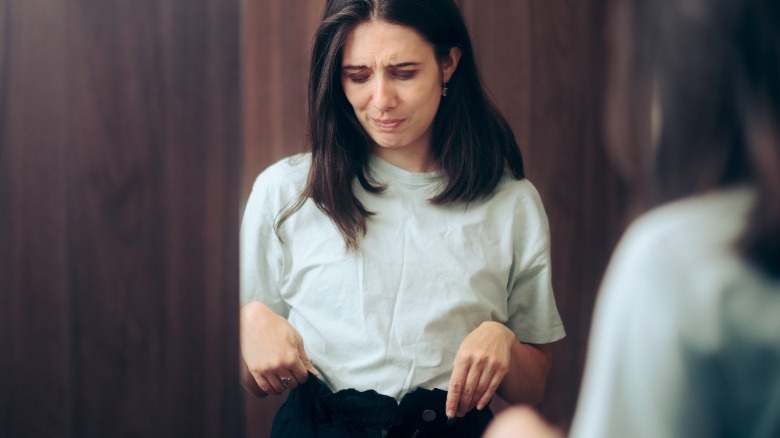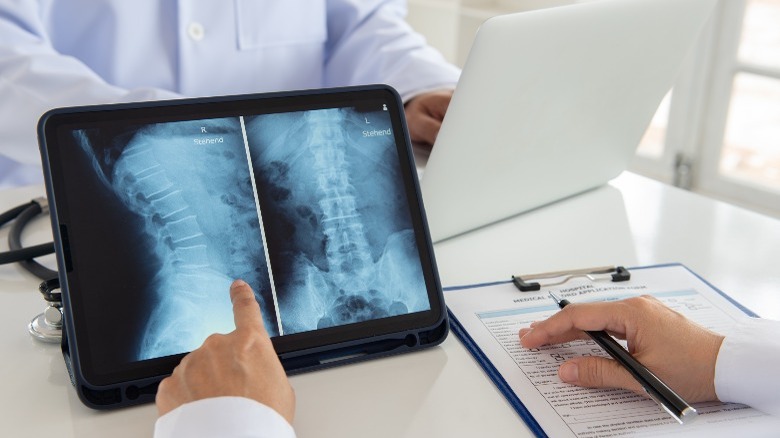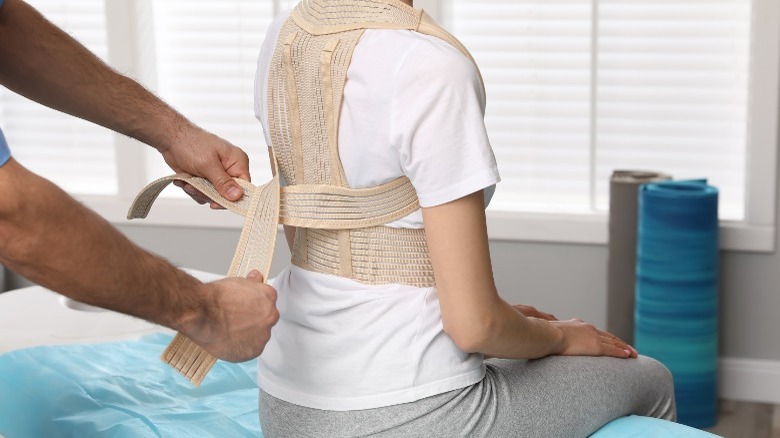Symptoms Of Scoliosis You Shouldn't Ignore
Scoliosis is a condition involving an abnormal spinal curvature of more than 10 degrees that can possibly get worse if left untreated (per the National Scoliosis Foundation). Unlike kyphosis, which is a forward rounding of the spine that results in a hunched posture, scoliosis causes the spine to curve laterally or sideways (via Penn Medicine).
According to the American Association of Neurological Surgeons (AANS), scoliosis affects 2-3% of the population and is generally found in those between the ages of 10 and 15. However, the condition is also seen in adults and infants (per the National Scoliosis Foundation). Women are more at risk for developing scoliosis and eight times more likely for the spinal curvature to be severe enough to require treatment (via AANS).
While causes of scoliosis vary for each individual, most cases have no known cause, explains the National Institute of Arthritis and Musculoskeletal and Skin Diseases (NIAMS). Referred to as idiopathic scoliosis, possible causes of the condition may include genes, hormones, or cell structure changes. Other cases in children are linked to congenital or neuromuscular diseases, spinal injuries, or tumors (per NIAMS).
Although scoliosis affects about 7 million Americans (via the National Scoliosis Foundation), an article in American Family Physician shares that only 10% need medical intervention. However, catching the condition as early as possible is crucial for less invasive treatment (via SpineUniverse). To help, here are some signs of scoliosis you shouldn't ignore.
The spine appears curved
The lateral curve in the spine caused by scoliosis will typically create a "C" or "S" spinal shape (via The Nemours Foundation), which may be visible just by looking at a person's back. This curvature is particularly noticeable when bending forward while standing and allowing the arms to hang loosely at the knees (per Medline Plus). Many schools and doctor's offices often use this bending test, called the Adam's forward bend test, to detect early signs of scoliosis, including an apparent sideways curve in the spine (via Physiopedia).
Because idiopathic scoliosis tends to occur during growth spurts in adolescents (via Medline Plus), it's a good idea to monitor your child's development. If you notice a curve in the back that resembles a "C" or "S" it may be time to speak with your doctor about possible causes, including scoliosis.
Also, you can ask your healthcare provider to conduct these tests for your children during routine visits to help identify abnormal curves in the spine. You may be referred to an orthopedic specialist if they find a pronounced spinal curve or other symptoms of scoliosis.
Uneven shoulder height
Another sign that the spine is curving in an atypical way is uneven shoulder height. As described by Healthline, uneven shoulders can signify structural or skeletal imbalances in the body caused by scoliosis. People with scoliosis have a sideways curve in the spine that can result in one shoulder dropping and the other rising, so the shoulders appear uneven (per Medical News Today). The more severe the spinal curve, the more prominent the shoulder imbalance is likely to be.
According to research published in the Journal of Orthopaedic Surgery and Research, shoulder imbalance is among the three main appearance abnormalities in which scoliosis patients feel the most concerned. The article also shares that even after surgery to correct scoliosis-induced spinal deformities, many patients still experienced unbalanced shoulders, showing the lasting impact that scoliosis can have on shoulder height.
However, there are other causes of shoulder asymmetry outside of scoliosis (via Healthline). To get the right diagnosis and treatment, it's essential to speak with your healthcare provider if you notice your shoulders appear uneven when standing straight.
Protruding shoulder blade
In addition to uneven shoulders, scoliosis can cause one shoulder blade to protrude outward in the upper back area more than the other (via the Mayo Clinic). For many scoliosis patients, the spine rotates as well as curves, causing a shoulder or other parts of the skeletal system to stick out on one side of the body.
Also, according to an article published in Consultant360, scoliosis may be connected to a condition called winged scapula, in which the shoulder blades stick out rather than lying flat or in line with the rib cage. While many scoliosis patients do not experience pain or discomfort due to their spinal curvature (per the Mayo Clinic), scapular winging is usually a painful condition that could affect how patients lift, pull, or push objects (via Healthline).
While a slightly protruding shoulder blade may not seem like an immediate cause for concern, it could be an early indicator of scoliosis, adds the Mayo Clinic. You should speak to your doctor about testing for scoliosis and possible treatment options that may help to prevent the condition from worsening.
Hips are not level
The spinal abnormalities caused by scoliosis can lead to a lateral pelvic tilt or uneven hips (per Healthline). When one hip appears higher or more rounded than the other, it means that the pelvis is tilted, creating an imbalance in the hips.
As explained by the CLEAR Scoliosis Institute, the spine is connected to the pelvis, so when the spine curves sideways, it pulls on the pelvis and affects hip alignment. As a result, the hip imbalance is typically worse when a person's spinal curvature is more severe.
In addition, scoliosis will result in the spine rotating or twisting, causing the pelvis to start to tilt unnaturally (per the CLEAR Scoliosis Institute). This misalignment may force surrounding muscles to compensate for the abnormality and protrude on one side, creating an uneven appearance in the hips. While standing straight, the hips should align horizontally with each other, be parallel with your shoulders, and not tilt forward or backward. If there is an issue with your hip alignment, it could signify spinal curvature and scoliosis that should be diagnosed and treated.
An uneven rib cage
Another symptom of scoliosis you should watch for is an uneven rib cage that may protrude from the chest or back on one side (via the Mayo Clinic). The spinal curvature and rotation caused by scoliosis can create a structural pull and push on the rib cage, which can result in a rib arch, according to the CLEAR Scoliosis Institute. As a way for the body to accommodate the spine's lateral curve, you may notice the ribs jutting out abnormally and asymmetrically (per Healthline).
In some scoliosis cases that become progressively worse, an uneven rib cage can become problematic. The Mayo Clinic explains that severe scoliosis can cause the rib cage to press against the lungs and make it harder to breathe for some people.
To help avoid these complications, speak to your healthcare provider right away if you notice that your rib cage appears uneven. There may be ways to treat the misalignment and alleviate symptoms.
Back pain
While not every person with scoliosis has back pain, many patients do experience pain in the lower back, stiffness, and postural muscle fatigue (via Healthline). According to American Association of Neurological Surgeons (AANS), about 23% of scoliosis patients report having back pain at the time of their diagnosis. Adults with scoliosis are generally more likely to have back pain than children or adolescents. However, more serious cases of scoliosis in children can cause painful symptoms as well (per Healthline).
A study published in Europe PMC shares that back pain increased with the degree of spinal curvature in participants, showing that more severe scoliosis can result in higher pain levels. However, scoliosis can potentially cause pain with mild spinal curvatures depending on the individual (via Spine-health).
Although there are many causes for back pain, experiencing ongoing discomfort in your back, along with other signs and symptoms of scoliosis, could mean it's time to talk to your doctor. Untreated scoliosis may become worse, which could then lead to increased back pain (via Europe PMC).
One leg is longer than the other
A review published in the Journal of Bone and Joint Surgery shows the connection between structural leg-length discrepancy (LLD) and functional scoliosis, which is scoliosis that results from changes in the lumbar spine to maintain shoulder balance when pelvic abnormalities are present. In these cases, the body compensates for imbalances by curving the spine to make up for the measurable discrepancy in leg length.
However, legs that appear to be different lengths can also result from idiopathic scoliosis. According to the CLEAR Scoliosis Institute, functional leg-length discrepancy, which is the appearance that the legs are not the same length when they actually are, may be caused by a scoliosis spinal curvature that creates a pelvic tilt. The misalignment in the pelvis causes the hips to become uneven, which affects the appearance of leg length.
Working with a professional spine specialist will help identify the cause of your LLD and how to best treat it. Whether scoliosis is the cause or the outcome of uneven legs, getting a diagnosis is the first step in seeking proper treatment.
Numbness or weakness in the legs
Spinal curvature due to scoliosis can stretch, pinch, or irritate nerves (per Healthline). When these nerves are affected by scoliosis, it can result in numbness or weakness in the legs, according to NHS Inform. The University of Maryland Medical System also confirms that adult scoliosis can cause pinched nerves, leading to numbness, cramping, and shooting pain, mainly felt in the legs.
While numbness may be a lesser-known sign of scoliosis than the more obvious physical symptoms of the condition, it's one that shouldn't be ignored. As explained by Medline Plus, one complication of scoliosis is nerve damage from an uncorrected spinal curve. Moreover, the Spinal Institute of Nevada shares that nerve compression from scoliosis can result in the development of back pain, and, "In very severe cases, nerve compression in the back can result in the loss of bowel or bladder control. Men may sometimes develop erectile dysfunction from nerve compression."
If you suspect you or your child may have scoliosis due to ongoing numbness or weakness in the legs, compressed nerves from spinal curvature may be the culprit (via Healthline). Talk to your doctor right away about the symptoms to possibly prevent further damage.
Always leaning to one side
Scoliosis can cause a spinal curvature that tilts the body in one direction or the other, making it appear as if you're leaning to one side even when you feel like you're standing straight up (per The Nemours Foundation). The tell-tale "S" or "C" curve in the spine found in people with scoliosis creates an asymmetry in the body that results in an obvious lean (via Johns Hopkins Medicine).
It's important to note that simply leaning or having poor posture does not cause scoliosis (via the UK Scoliosis Clinic). In fact, the condition often has no clear cause at all (per Healthline). It's when you develop a spinal curvature that leads to changes in posture, such as always leaning to one side, that may give you cause for concern. Untreated scoliosis has the potential to worsen with time and cause substantial complications in severe cases, according to the Mayo Clinic. However, the only way to get to the bottom of what's causing the leaning is to consult a medical professional.
Changes in walking
A study published in the Annals of Physical and Rehabilitation Medicine found that spinal curvatures in people suffering from adolescent idiopathic scoliosis (AIS) can cause changes to the way they walk — referred to as gait patterns. With decreased hip and pelvic motion due to scoliosis, the study results showed an asymmetry in stepping patterns and ground reaction force. It also mentions an excessive energy cost of walking in participants, meaning they used more energy to walk than average (per a review in the Archives of Gerontology and Geriatrics).
Likewise, Rehabilitacja Medyczna published a study that found changes in body mechanics in participants with scoliosis, including pelvic tilts, pelvic rotations, knee flexing, and range of motion, that had an effect on gait patterns. These studies show that scoliosis can impact the way a person walks, depending on the spinal curvature.
If you've noticed changes in the way your child is walking or even your own walking pattern, it's best to speak with your doctor about any scoliosis concerns you may have. Your healthcare provider may choose to conduct tests that should help diagnose the issue.
Clothing doesn't fit right
According to Spine-health, an early sign of scoliosis may be clothing that fits awkwardly or hangs off the body in an uneven way. The CLEAR Scoliosis Institute also shares how the asymmetrical effects of scoliosis can cause clothing to not fit the way it should. Mild curves in the spine can develop very gradually, making it difficult to notice them right away (via the Mayo Clinic). However, changes in the way clothes fit can make the curvature more visually apparent.
Many scoliosis treatment and support centers, like Scoliosis SOS Clinic, even share tips on how people with scoliosis can dress to feel less self-conscious about their spinal curves and to draw attention away from the physical symptoms of the condition.
If there's no obvious reason why your clothing is not fitting right, you may want to consider the possibility of changes to your spine caused by scoliosis (per the NHS). Speak with your doctor about the symptoms of scoliosis and how to determine if you or your child may have the condition.
Diagnosing scoliosis
For those who suspect you or your child may have scoliosis, medical professionals can use several methods to confirm a diagnosis. Catching scoliosis early will make it easier to treat and avoid the possible complications that come with cases that become progressively worse (via SpineUniverse).
A doctor can diagnose scoliosis by conducting a physical exam and taking images with x-rays, spinal radiographs, CT scans, or MRI scans, according to the American Association of Neurological Surgeons (AANS). These methods will detect the curvature in the spine and the degree of the curve. According to Nationwide Children's Hospital, a curvature that measures greater than 10 degrees is considered scoliosis. Anything less than that is labeled as "spinal asymmetry," which usually doesn't need treatment.
As explained by The Nemours Foundation, spinal curves that are less than 20 degrees are considered mild, between 25 and 40 degrees are moderate, and more than that is severe. Based on these measurements, your doctor will work with you on a treatment plan to keep the curvature from worsening.
Treatment for scoliosis
A scoliosis diagnosis may be alarming and worrisome for parents. However, there are several treatment options that can help to manage the condition or even correct the spine. According to the American Academy of Orthopaedic Surgeons (AAOS), some treatments for scoliosis include regular monitoring, exercise, wearing a brace, and surgery.
When the spinal curvature is considered mild or less than 20 degrees, your doctor will most likely choose to monitor the curve to ensure it doesn't get worse (per AAOS). They will typically take x-rays every six months and monitor the condition until adulthood. Curves that remain less than 30 degrees in someone who is fully grown will usually stay the same and not progress (via AAOS).
Some scoliosis patients will need to wear a brace to prevent further curving of the spine. The AAOS shares that people with moderate curvatures, a progressing curve, or a curve that was more than 30 degrees at the initial diagnosis and is still growing could benefit from wearing a brace. According to the Boston Children's Hospital, about 75% of patients with moderate scoliosis receive successful treatment with a brace.
With more severe cases of scoliosis, spinal fusion surgery may be necessary to correct the curvature and improve the patient's quality of life (via AAOS). The procedure involves realigning the spine and fusing the vertebrae into a single bone to stay straight. However, surgery is usually only recommended for those with spinal curvatures measuring between 40-50 degrees.

